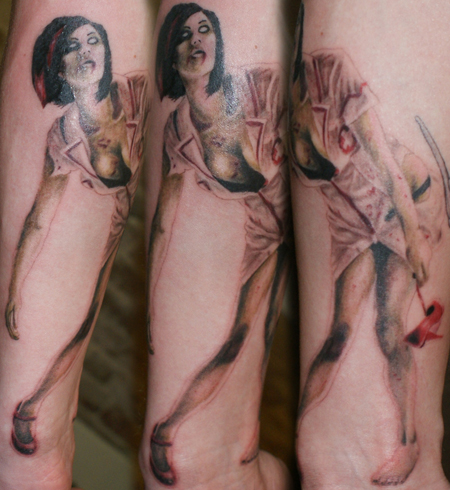Pin Up Girl Tatoos
In the 1940s, the term 'pin-up' was coined to refer to women who were attractive and beautiful, the kind of women men would want to pin to their wall. Traditionally, most pin-up girl designs are commercial-looking and somewhat mass-produced. A the time, the Pop Art movement was underway and women like Marilyn Monroe were famous for their sexuality.
The pin-up girls are poised in seductive, alluring, or coy positions. They are usually scantily clad, often showing their mid-drifts, legs, and cleavage. Backs, shoulders, and butts were also featured.
Sometimes the women were comical and funny, with humorous expressions on their faces, while other times they were innocent and sweet looking, with wide-eyes and a trusting expression.
It is important to note that most pin-up art was drawings and paintings, rather than photographs. Although there were real-life pin-up models, most were the creation of artists.
In the body modification community, tattoos of pin-up girls have been common since the art first became popular. Pin-ups are part of the original Old School tattoo design, perhaps the first modern tattoo style trend, dating back to the 1950s.
Original vintage pin-up tattoos featured girls in a variety of sexy positions, clad in anything from swim suits to sailor outfits to bath towels. Today, pin-up tattoos usually harken back to the first era, copying the Old School design or morphing it into the popular New School style.
The designs are still iconic, sexy women in alluring positions who are usually clad in next to nothing. The themes of pin-ups, however, has evolved and continues to evolve.
Original pin-ups were favored by sailors, so they often sported hula girl costumes, navy uniforms, patriotic outfits, or clothing inspired by a girlfriend or loved one, like a cowgirl or nurse.
Modern pin-ups often venture into more bizarre areas. Zombie pin-ups have become quite common. These undead pin-up girls usually still look like the old ones, but are colored green, are covered in blood, or might even be rotting and decaying. Zombies have become a very important pop-culture symbol, which connects to the Pop Art birthplace of the pin-up girl.
Other pin-up variations include styles from other cultures, like geishas or Native Americans, and even from another world, like aliens, vampires, or robots. An important aspect of pin-up girl tattoos, whether from the 1950s or from today, is the style the woman is drawn in.
She is usually 2-dimensional and is often colorful. Pin-up girls are typically outlined in black ink with flat representation. Sometimes, though, the designs can be black and white or involve shading and intricate detailing. Usually, pin-up girl tattoos are not realistic, even when the girl is designed to look like an actual person.
Some popular larger motif tattoos feature pin-up girls. Lady Luck, the embodiment of good fortune, is usually illustrated as a pin-up who wears symbols of gamboling and games of chance, like dice, playing cards, and poker chips. She is sometimes called Miss Fortune, too.
Man's Ruin, another popular tattoo design, usually features a pin-up style demon woman who is enticing men to their destruction, seducing them and tempting them. Of course, pin-up style tattoos, considered part of the retro trend in tattooing, have become popular with more than just sailors and those serving in the military.
People who are interested in the history of tattoo, the origins of the art form, or those who have studied art and are drawn to aspects of the Pop Art movement might be interested in pin-up girl tattoo, either in the Old School or New School style.
Unlike in the 1940s and 1950s when pin-up girls first became tattoo designs, more and more women are choosing the style for their own body artwork. Women today seem more freely able to appreciate the female form and revel in their own sexuality and erotic natures.
For many women, pin-up girls represent a classic tattoo design that is still unbelievably sexy.





























